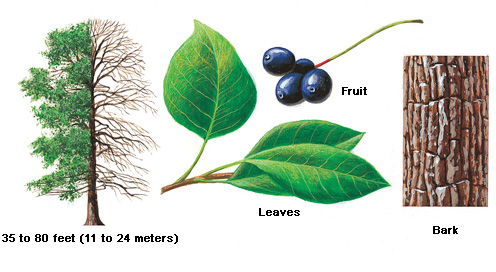Tupelo, << TOO puh loh, >> is the name of several attractive trees native to North America and Southeast Asia. Tupelos bear tiny greenish-white flowers and berrylike fruits. The fruits provide food for migrating birds. Tupelo wood is light-colored and used to make baskets, paneling, pulp, shipping boxes, tool handles, and woodenware. Bees collect nectar from the flowers of certain tupelo trees to make tupelo honey.


The water tupelo, also known as sourgum or tupelo-gum, reaches heights of up to 115 feet (35 meters). It grows in swamps in the Southeastern United States. The trunk of the water tupelo is swollen at the base and may be more than 7 feet (2.1 meters) wide. Its large pointed leaves turn scarlet in the fall. The water tupelo bears fleshy reddish-purple fruits.
The black tupelo, also called blackgum or pepperidge, usually grows from 35 to 80 feet (11 to 24 meters) tall. It is found in moist woods or swamps in the Eastern, Southern, and Midwestern United States; in southern Ontario in Canada; and in parts of Mexico. The black tupelo has glossy leaves. In autumn, the leaves turn brilliant scarlet, orange, and yellow, and blue-black fruits appear. The black tupelo is sometimes planted as a yard or street tree.
The Ogeechee tupelo, also called Ogeechee-lime, is a medium-sized tree that grows from 30 to 40 feet (9 to 12 meters) tall. It may also be a large shrub. The Ogeechee tupelo grows only in stream banks and river swamps in the southern tip of South Carolina, in Georgia, and in northern Florida. Its sour, bright red fruits are used to make preserves.
